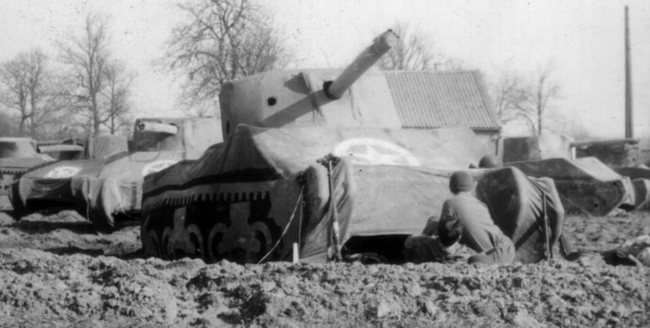The Mission
Operation Viersen
March 1945

This was the final performance of the 23rd, and the most dramatic. In March of 1945, as the 9th Army prepared to cross the Rhine into Germany, the 23rd was called upon to feint a crossing in a different place to draw German units away from the point of the real attack. The effort required the 1000 men of the 23rd to use every resource at their disposal as they impersonated two full divisions, some 40 thousand men.
It began with phony convoys hitting the road, and spoof radio networks giving the impression of major forces on the move. When they reached the Rhine, more than 600 inflatable tanks and artillery were set up. Camoufleurs laid down smokescreens. The sonic crews worked around the clock. At night they played the sounds of trucks rolling in. In the daytime they played sounds of heavy construction, as if bridging units were being put together. (Actual bridging units were also attached to 23rd and assembled some real bridge sections to give credibility to the illusion) Crews kept up a pretense of artillery fire by setting off flash canisters. The Germans responded with heavy artillery fire of their own, but the only tanks and guns they damaged were rubber inflatables, and the men scurried around to fix them.
 The result was extremely successful. Intelligence reported German units converging across the river from the deception. When the two divisions being impersonated by the 23rd attacked miles up the Rhine, they met only disorganized resistance and suffered an astonishingly low number of casualties. Ninth Army commander William Simpson issued the 23rd a commendation: The careful planning, minute attention to detail, and diligent execution of the tasks to be accomplished by the personnel of the organization reflect great credit on this unit.
The result was extremely successful. Intelligence reported German units converging across the river from the deception. When the two divisions being impersonated by the 23rd attacked miles up the Rhine, they met only disorganized resistance and suffered an astonishingly low number of casualties. Ninth Army commander William Simpson issued the 23rd a commendation: The careful planning, minute attention to detail, and diligent execution of the tasks to be accomplished by the personnel of the organization reflect great credit on this unit.
It began with phony convoys hitting the road, and spoof radio networks giving the impression of major forces on the move. When they reached the Rhine, more than 600 inflatable tanks and artillery were set up. Camoufleurs laid down smokescreens. The sonic crews worked around the clock. At night they played the sounds of trucks rolling in. In the daytime they played sounds of heavy construction, as if bridging units were being put together. (Actual bridging units were also attached to 23rd and assembled some real bridge sections to give credibility to the illusion) Crews kept up a pretense of artillery fire by setting off flash canisters. The Germans responded with heavy artillery fire of their own, but the only tanks and guns they damaged were rubber inflatables, and the men scurried around to fix them.
 The result was extremely successful. Intelligence reported German units converging across the river from the deception. When the two divisions being impersonated by the 23rd attacked miles up the Rhine, they met only disorganized resistance and suffered an astonishingly low number of casualties. Ninth Army commander William Simpson issued the 23rd a commendation: The careful planning, minute attention to detail, and diligent execution of the tasks to be accomplished by the personnel of the organization reflect great credit on this unit.
The result was extremely successful. Intelligence reported German units converging across the river from the deception. When the two divisions being impersonated by the 23rd attacked miles up the Rhine, they met only disorganized resistance and suffered an astonishingly low number of casualties. Ninth Army commander William Simpson issued the 23rd a commendation: The careful planning, minute attention to detail, and diligent execution of the tasks to be accomplished by the personnel of the organization reflect great credit on this unit.



